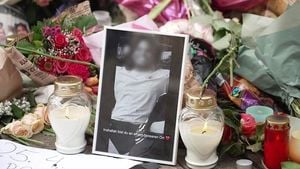In the gripping new Netflix series The Glass Dome, viewers are drawn into a haunting narrative that intertwines the past and present of its protagonist, Lejla Ness. Based on an original story by Swedish crime author Camilla Läckberg, the series stars Léonie Vincent as Lejla, a criminologist who returns to her small hometown of Granås, Sweden, following the death of her adoptive mother. This visit, however, quickly spirals into a chilling investigation when a local child goes missing, evoking painful memories of Lejla's own abduction as a child.
Lejla's return to Granås is marked by a mix of nostalgia and dread. She reunites with her adoptive father, Valter Ness, played by Johan Hedenberg, a former police officer whose own burdens are palpable. The emotional distance between Lejla and Valter is evident, particularly as she grapples with the trauma of her childhood. As a child, Lejla was kidnapped and held captive in a glass dome, a nightmare that still haunts her.
Things take a dark turn when Lejla visits her childhood friend Louise, only to find her dead in the bathtub, a deep cut on her arm suggesting suicide. The tragedy intensifies when it becomes clear that Louise's daughter, Alicia, is missing. The local authorities, led by police chief Tomas (Johan Rheborg), mobilize to search for the girl, treating the case as a potential crime when Alicia's clothes are found near an old mine.
“With Louise's death, Lejla loses one of the few people she can feel safe with,” Läckberg and director Lisa Farzaneh explain. “Louise's death also heightens the worry about what has happened to Alicia; it shows clearly that she is with someone who does not hesitate to kill.”
As the investigation unfolds, suspicion falls on Said, Alicia's father, who is already grieving the loss of his wife. Tomas interrogates him, suggesting that his calm demeanor is suspicious for a man in mourning. The line between investigation and persecution blurs, raising questions about the integrity of the local police force.
Determined to uncover the truth, Lejla takes matters into her own hands. She and Valter revisit the site where Alicia's clothes were discovered, realizing they were worn at Ann-Marie's funeral just days before the disappearance. This detail narrows the timeframe for the possible kidnapping, leading them to investigate builders who had recently worked on the family’s roof. One builder, Maksim, is found to have been close with Alicia, but ultimately clears himself of suspicion.
Haunted by her own past, Lejla reviews old recordings from her kidnapping case and recalls her captor, a man she refers to as Ecki. This figure, who gave her dolls and cut the hair of his victims, becomes a chilling reminder of the danger Alicia now faces. “These details echo in Lejla's current investigation,” the creators note, suggesting a disturbing parallel between the two cases.
As tensions rise, a shocking revelation comes to light: Tomas had an affair with Louise during her separation from Said, leading Valter to question his ability to lead the investigation. This personal entanglement complicates matters further, as Lejla and Valter feel compelled to take a more active role in seeking justice.
In the midst of the chaos, a new character emerges—Martin, who approaches Lejla in a café, claiming to be fascinated by her story. However, it is later revealed that his true identity is Daniel Frick, who has recreated Lejla's original kidnapping by abducting a girl named Elma. This adds another layer of complexity to the investigation, as it becomes clear that there are those who idolize criminals and seek to emulate their actions.
As Lejla digs deeper, her suspicions about Tomas grow. However, it turns out he is merely trying to hide his affair with Louise. The real shock comes when Lejla discovers that Valter, her adoptive father, is actually the infamous Ecki—the man who kidnapped her as a child. This revelation is nothing short of devastating, as it becomes clear that Valter has once again taken a child captive, this time Alicia.
In a heart-pounding climax, Tomas returns to Valter's house, where he discovers a dead police officer and uncovers a hidden underground chamber. Inside, he finds Alicia unconscious and Lejla trapped inside a glass dome, desperately trying to draw attention to their plight. Just in time, Tomas manages to rescue both girls, arresting Valter in the process.
In the series finale, Lejla confronts Valter in prison, seeking answers about the other victims. His chilling response reveals the true horror of their past: the bodies are in a lake where he used to take her as a child. Valter’s obsession with Lejla is laid bare, as he admits to kidnapping her after becoming infatuated with her at a town event. “He uses love as a way to keep his control of her,” Läckberg explains. “Love is the way he lures her in, and what keeps her close to him.”
The series, rich with suspense and emotional depth, explores themes of trauma, obsession, and the darkness that can lurk beneath the surface of seemingly normal lives. As Lejla navigates her past and fights to save Alicia, viewers are left questioning the nature of evil and the complexities of familial bonds.
With its compelling narrative and strong performances, The Glass Dome promises to captivate audiences, drawing them into a world where secrets and shadows intertwine, and where the past is never truly buried.







